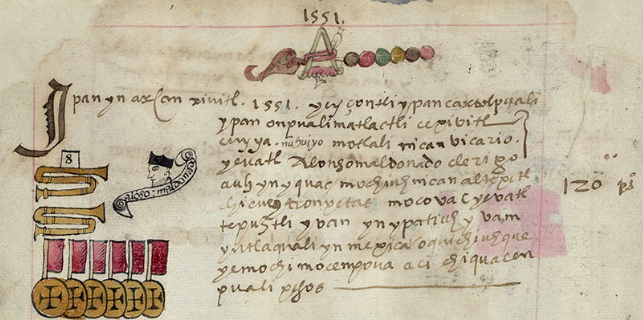chicuei trompetas (CST2)
This is a painting of chicuei trompetas (“eight trumpets”), from a page dated 1551 of the Códice Sierra-Texupan. It involves a simplex glyph plus a notation. Trompeta is a loan taken into Nahuatl from the Spanish. It refers to what were called trumpets in this context. The glyph shows two of them, but then includes the digit 8 above the musical instruments as a notation for how many there were in all. The instruments have an S-shape, with a belled horn at each end. They have seams where the various metal tubes are joined. The cost for this purchase was 120 pesos, as shown in the contextualizing image.
Stephanie Wood
This was a significant purchase for the community. And eight more trumpets are shown on Plate 29. The instruments were probably destined for a church band. Given the pre-contact religious interest in serpents such as Quetzalcoatl, these trumpets may have been admired for their serpent-like shapes. But the instruments were probably medieval or early modern. Juan José Batalla Rosado suggests the name sacabuche or trombón for the S-shaped instrument that appears in the Matrícula de Huexotzinco. (See his article in El Arte de Escribir (2018), p. 108, and the Chamil glyph, below.) Musical museums do have serpent-shaped instruments from the nineteenth century, such as the “bauduoin.” For more on the Codex Sierra, see Kevin Terraciano’s study (2021).
Stephanie Wood
1550–1564
Jeff Haskett-Wood
instrumentos, trompetas, música

trompeta, trumpet or horn (a loan from Spanish), https://nahuatl.wired-humanities.org/content/trompeta
ocho trompetas
Stephanie Wood
Codex Sierra-Texupan, plate 2, page dated 1551. Origin: Santa Catalina Texupan, Mixteca Alta, State of Oaxaca. Kevin Terraciano has published an outstanding study of this manuscript (Codex Sierra, 2021), and in his book he refers to alphabetic and “pictorial” writing, not hieroglyphic writing. We are still counting some of the imagery from this source as hieroglyphic writing, but we are also including examples of “iconography” where the images verge on European style illustrations or scenes showing activities. We have this iconography category so that such images can be fruitfully compared with hieroglyphs. Hieroglyphic writing was evolving as a result of the influence of European illustrations, and even alphabetic writing impacted it. https://bidilaf.buap.mx/objeto.xql?id=48281&busqueda=Texupan&action=search
The Biblioteca Digital Lafragua of the Biblioteca Histórica José María Lafragua in Puebla, Mexico, publishes this Códice Sierra-Texupan, 1550–1564 (62pp., 30.7 x 21.8 cm.), referring to it as being in the “Public Domain.” This image is published here under a Creative Commons license, asking that you cite the Biblioteca Digital Lafragua and this Visual Lexicon of Aztec Hieroglyphs.





